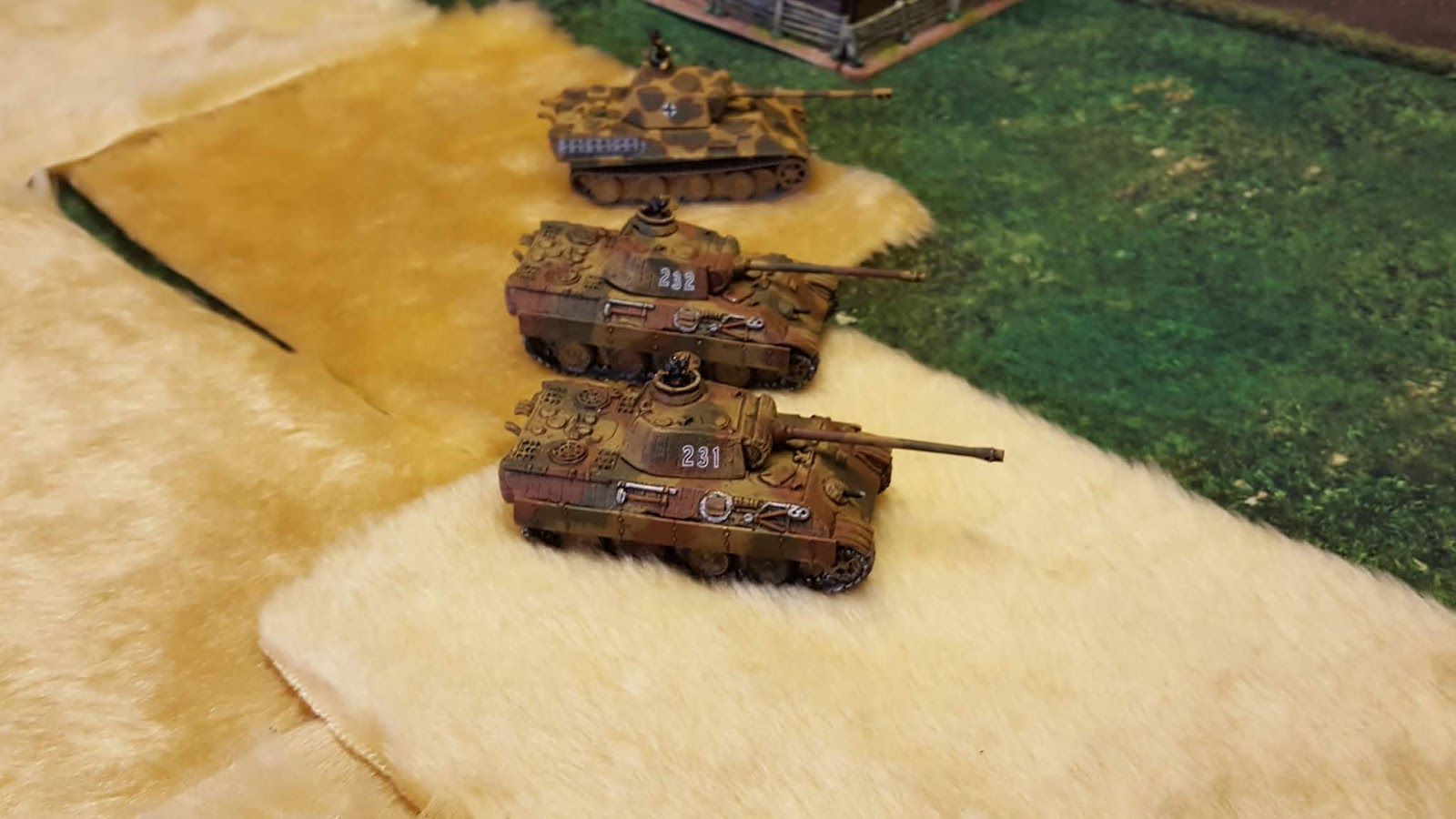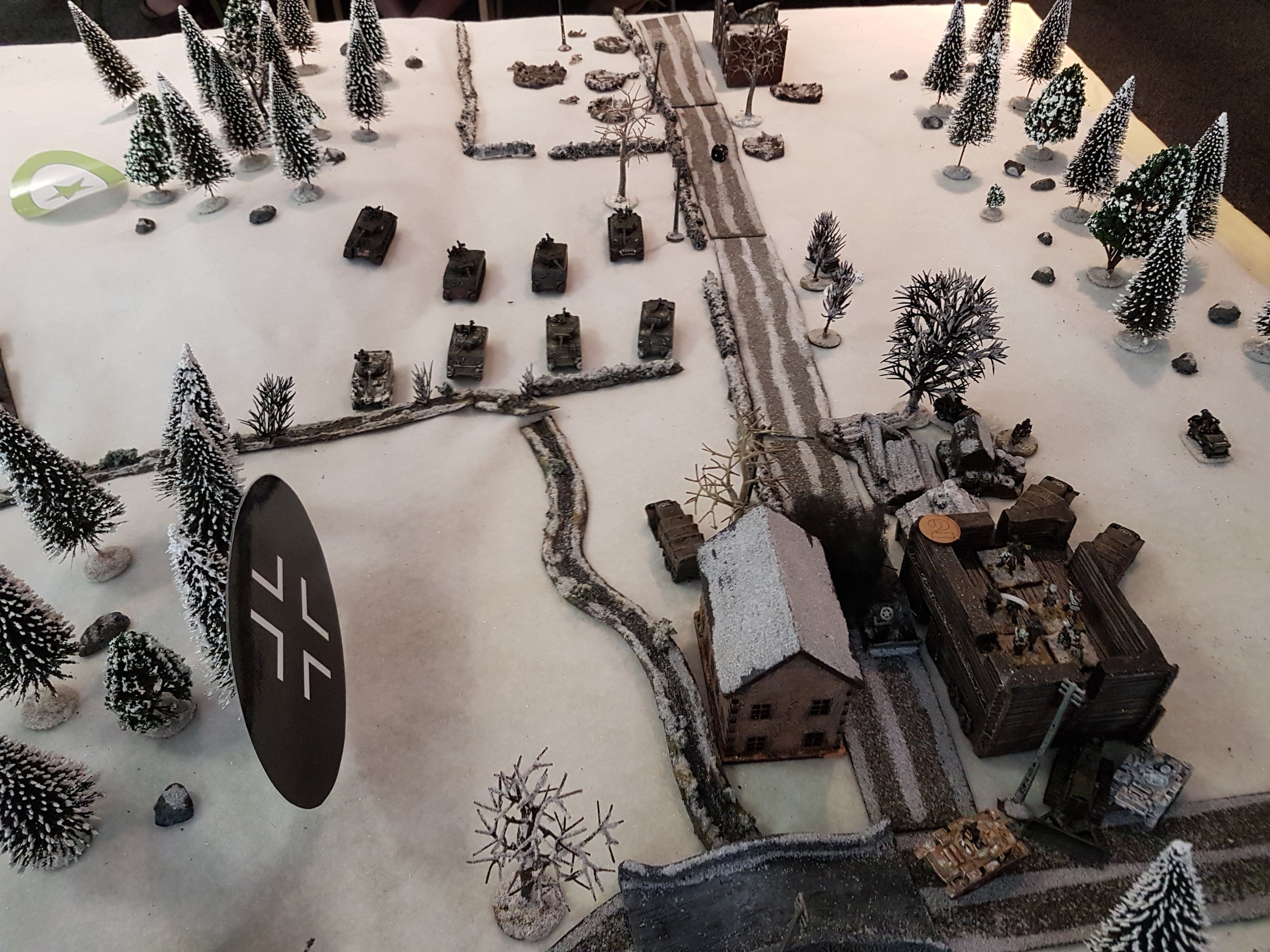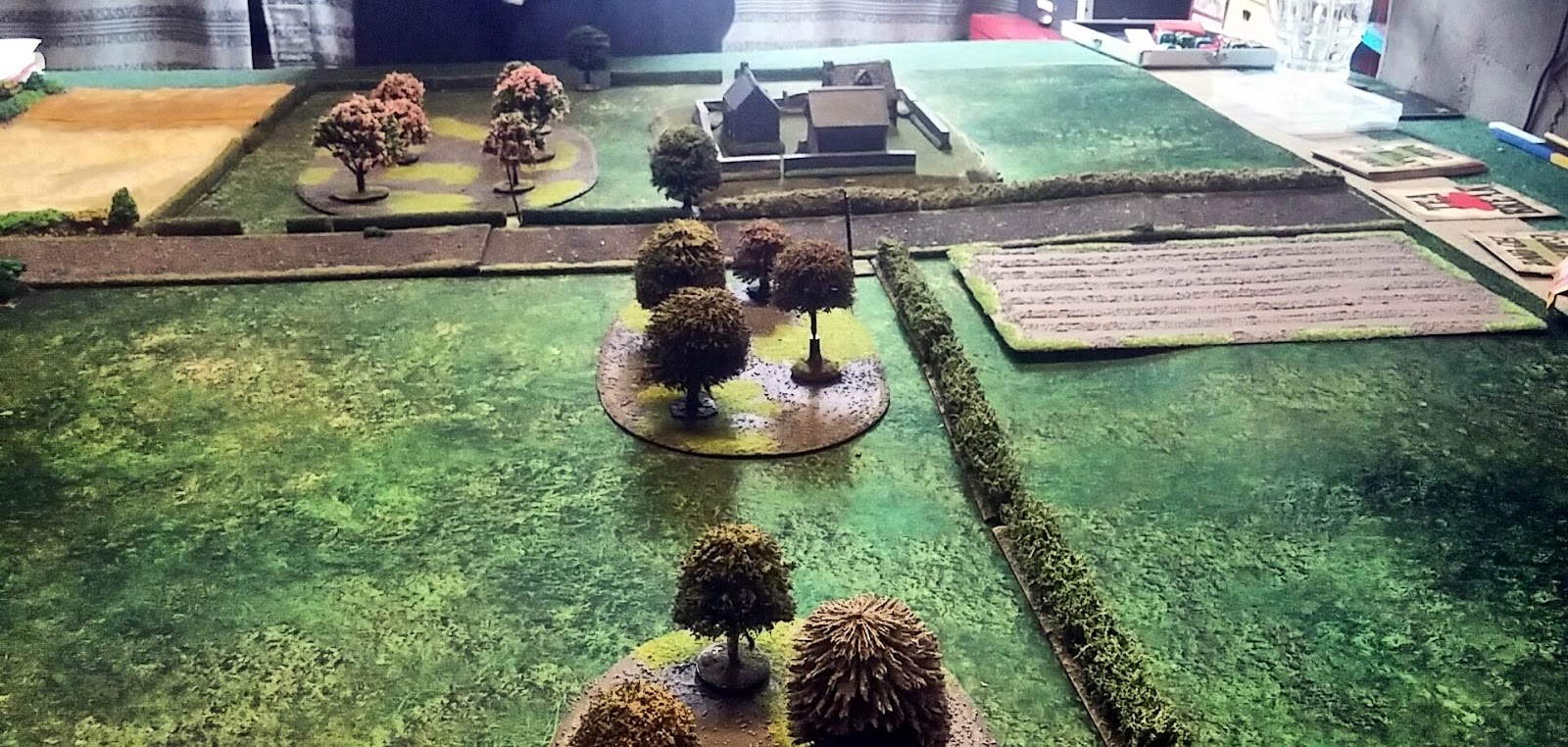Our last game of IABSM was set in the Tuchole Forest in Poland, right at the beginning of the war. Today’s battle would directly follow on from that encounter, and represent the stalwart Polish defence of Grudziadz. Both scenarios were taken from The September War, Part One, one of the TooFatLardies scenario packs that I have written for I Ain’t Been Shot, Mum!
The eastern edge of Grudziadz. The corner of the objective area is defined by the ammo dump in the foreground.
Background
Grudziadz was a strategically important town as it housed an officer academy, a cavalry school and the several army staffs directing Polish forces in the Polish Corridor region. It was, however, only lightly defended, with its garrison made up of infantry and border protection corps (KOP) along with supporting artillery. The German attack was launched from East Prussia by 21st Corps, mainly infantry and the reserve 10th Panzer regiment (mainly Panzer I and II).
This game was to be a battle for territory. The Poles would begin the game in a square objective area whose on-table corner was defined by the ammo dump in the foreground of the picture above: to define the square, take a line straight out to each table edge (i.e. north along the road past the church and west along the road towards the tape measure). The Germans had to penetrate and have active units within that square on every turn from the eighth appearance of the Turn Card. Failure to do so would lose them the game, with the game ending when it was obvious that either (a) the Germans were not going to get into Grudziadz or (b) the Germans were in, and wouldn’t be shifted.
The Poles
The Poles, played by Dave and winners of the last game, consisted of three 2-squad platoons of infantry: two of regulars, one of KOP. Each of the regular platoons also had an anti-tank rifle team and a light mortar team. These were supported by three taczankas (MMGs on custom-built, horse-drawn carriages), three anti-tank guns, two medium mortars, some off-table artillery (the FOO was in the church steeple), and (incredibly) a flight of PZL37 ground-attack bombers.
Although they knew the Germans were coming from the east, they didn’t know how the attack would fall, so the Poles chose to defend across the eastern face of Grudziadz with their regular infantry forward. Just off the bottom edge of the photo below is another AT gun and taczanka hidden in a small wood just north of the back end of the church. The KOP, one taczanka and one anti-tank gun would be in reserve.
Slightly after the start of the battle. One squad has already taken casualties.
The Germans
The German force consisted of a three-platoon company of infantry, with each platoon containing three squads of infantry. These were supported by a four-gun machine-gun platoon and a couple of AA half-tracks. Accompanying the infantry was a strong force of panzers: an HQ platoon with a Panzer I Befelswagon, a Panzer I and two Panzer IIs; and then two panzer platoons ach of three Panzer IIs and two Panzer Is. Although all the tanks were light, the 20mm autocannons on the Panzer IIs looked like excellent suppression weapons.
My plan was simple. Ignore the bottom half of the table and just drive everything towards the north side of the church. Ignore casualties amongst the panzers and just aim to get one deep into Grudziadz itself, hiding somewhere towards the back of the village until the end of the game.
Note that as the Germans had lost the last game, my MMGs and AA half-tracks would begin the game off table, with me rolling to see if they arrived.
Here’s the German force advancing forward after a round or so of Polish spotting:
The Battle for Grudziadz
As the game began, the Germans hurled themselves forward, aiming their schwerepunkt at one end of the Polish line. Although the Poles had anticipated that the Germans might come that way (hence the two anti-tank guns and the taczanka), the sheer size of the German thrust was still quite a surprise (ooh, er, madam!).
For those interested in the nuances of how the Blinds rules in IABSM play (a frequent question on the Forum) I chose to deploy all my troops from Blinds as soon as possible: turn one or two, I think. Why? Well although this potentially exposed me to fire as I went in, and could have led to a somewhat fragmented attack (as different units moved on their individual cards as opposed to en masse under Blinds), deploying everything meant that I flooded the deck with my cards giving me a much greater potential for action.
I’m sure the mathematicians amongst you could define this properly, but if there’s a 50% chance of a unit’s card appearing before Tea Break, the composition of the deck once I’d deployed gave me a lot of 50% chances of a unit or Big Man’s card appearing versus the Poles’ one 50% chance that their Blinds card appeared.
The endless stream of your side’s cards is also excellent for hammering your opponent’s morale. Seriously: don’t underestimate the effect of having to sit there and watch your enemy’s troops moving and firing again and again as you have to wait for your card to appear.
This why you shouldn’t adopt the Skelton Gambit optional rule (you can voluntarily deploy from Blinds on Tea Break) as using Blinds is a key skill in IABSM: the equivalent of having great reconnaissance or approach skills!
The net result of all this was that the Germans managed to cross all the open ground north-east of the church for the loss of three infantrymen and one gun disabled on the Befelswagen. The Polish defenders were doing their best, but their anti-tank guns were being hit and pinned by Panzer II 20mm autocannon every turn.
Beware the rings of death!
As the Germans were pouring forward, the Poles were desperately trying to deploy their reserves and redeploy some of their troops towards the north, but another German infantry platoon had gone to ground in front of the southern part of the Polish line, keeping them occupied. Worse, the German MMG platoon, although late, had now arrived, and was also threatening to set up opposite the ammo dump.
The Germans kept pushing forwards, and although they had now lost a few tanks (none destroyed: the crews abandoning after their tanks were immobilised) they were now close enough to run right over the opposition.
Shoot at me, would you!
The German infantry just by the church also charged forward in an attempt to rush the Polish trenches there. Unfortunately, the way the cards turned meant that I had to charge my men forwards without having properly Pinned the Poles first. I had to do it then, as otherwise the Poles might have been reinforced, but the resultant combat, although it resulted in a German win and the capture of the Polish position, cost me dear: only eight men and the Big Man surviving from a platoon of twenty-four.
With their being a convenient door just nearby, this meant that I would almost certainly be able to get into the church before the squad of Polish KOP infantry got into it from the other side, and once I had the church, I was confident that I had the game sown up.
As always, pride, hubris, call it what you will, comes before a fall, and the drone of aircraft engines was heard overhead. Yes: the Polish airforce had arrived.
Bombs whistled down from above, and despite my protestations about aiming at houses of God etc, landed right on my men lurking outside the church. They were all blown to atoms, and the two panzers rattled around as well!
Boom!
This was a pretty severe set-back, as it was going to be real pain winkling the Poles out of the church if the KOPs got in there.
Fortunately, I now had so many panzers forward that I was able to get a few tanks around the church and effectively into a position behind the main Polish line from which I could either bring those defenders under fire, or shoot at any Poles moving forward as reinforcements. I also had my final infantry platoon in a position where they could head towards the church and at least arrive at the same time as the opposition (and in greater numbers).
At this point, the Poles conceded, recognising that they were never going to be able to evict me from the objective area.
Aftermath
It had been a great game, and finished (for those who think that IABSM always takes a long time to play) in about 2½ hours.
Key to the German success had been the decision to schwerepunkt at one point of the Polish line rather than an attempt to suppress their entire defensive line at the same time. If I was playing it again, I might aim at the other end of the Polish line (i.e. down by the ammo dump) but there were, I felt, more opportunities to the north than to the south.
Kudos to Dave, who had correctly predicted my main axis of attack, but not perhaps that I would throw so much into it.
Next up: the defense of Gdynia.
Robert Avery
Memo to self: don’t forget AA guns are only effective within 24” of where the air attack goes in!







































































































































